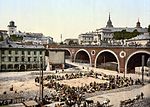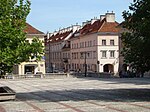Kazanowski Palace
1643 establishments in the Polish–Lithuanian CommonwealthDemolished buildings and structures in PolandFormer buildings and structures in PolandHouses completed in 1643Palaces in Warsaw

The Kazanowski Palace (Polish: pałac Kazanowskich), also known as the Radziejowski Palace, was a large palace in Warsaw, occupying the place where the Charitable Center Res Sacra Miser stands today.
Excerpt from the Wikipedia article Kazanowski Palace (License: CC BY-SA 3.0, Authors, Images).Kazanowski Palace
Bednarska, Warsaw Śródmieście (Warsaw)
Geographical coordinates (GPS) Address Nearby Places Show on map
Geographical coordinates (GPS)
| Latitude | Longitude |
|---|---|
| N 52.245 ° | E 21.015 ° |
Address
Bednarska 28/30
00-321 Warsaw, Śródmieście (Warsaw)
Masovian Voivodeship, Poland
Open on Google Maps











